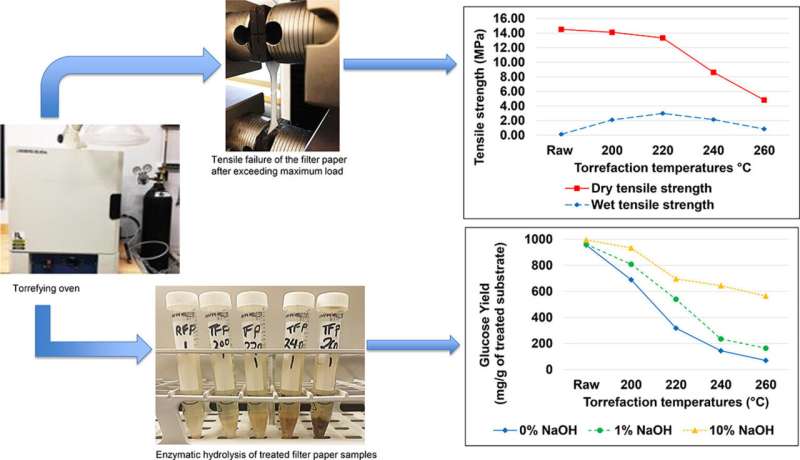Stronger paper bags—reused repeatedly then recycled for biofuel—could be the future

As the world searches for ways to reduce the use of plastics such as single-use plastic bags, a novel study by Penn State researchers demonstrates a process to make paper bags stronger—especially when they get wet—to make them a more viable alternative.
The study suggests a process for creating paper bags durable enough to be used multiple times and then broken down chemically by an alkaline treatment to be used as a source for biofuel production, according to researcher Daniel Ciolkosz, associate research professor of agricultural and biological engineering.
“When the primary use of these paper products ends, using them for secondary purposes makes them more sustainable,” he said. “Recycling and reducing paper waste also helps in reducing total solid waste destined for landfills. This is a concept we think society should consider.”
Lead researcher Jaya Tripathi, who will graduate from Penn State this spring with a doctoral degree in biorenewable systems and has accepted a position at the Joint BioEnergy Institute in California, devised an innovative process in which cellulose in paper is torrefied, or roasted in an oxygen-deprived environment, to greatly increase its tensile strength when wet.
Paper bags are a popular alternative to plastic bags to reduce the environmental impacts caused by using plastics, she explained, but paper bags have short lifespans due to their low durability, particularly when wet. And a paper bag must be reused several times to reduce its global-warming potential to below that of the conventional high-density polyethylene bag, Tripathi added.
“Reuse is mainly governed by bag strength, and it is unlikely that a typical paper bag can be reused the required number of times due to its low durability upon wetting,” she said. “Using expensive chemical processes to enhance wet strength diminishes paper’s ecofriendly and cost-efficient features for commercial application, so there is a need to explore non-chemical techniques to increase the wet strength of paper bags. Torrefaction could be the answer.”
Because torrefaction decreased the glucose yield in the paper, she then treated the paper with a solution of sodium hydroxide, also known as lye or caustic soda, that increased its glucose yield, making it a better source for biofuel production.
In findings recently published in Resources, Conservation and Recycling, using filter paper as the medium, the researchers reported that the wet-tensile strength of the paper increased by 1,533%, 2,233%, 1,567% and 557% after torrefaction for 40 minutes at 392 degrees Fahrenheit, 428 F, 464 F and 500 F, respectively.
Glucose yield decreased with increased torrefaction severity, but after treating torrefied paper samples with an alkaline sodium hydroxide solution, glucose yield increased, the researchers noted. For instance, the glucose yield of raw filter paper was 955 mg/g of substrate, whereas it was 690 mg/g of substrate for the same paper sample torrefied at 392 F. The glucose yield increased to 808 and 933 mg/g of substrate with 1% and 10% alkaline treatment, respectively.
The need for a concept like the one demonstrated by the researchers to replace plastic bags is obvious, Tripathi pointed out. According to the U.N. Environment Program, 5 trillion plastic bags are produced worldwide annually. It can take up to 1,000 years for these bags to disintegrate completely. Americans throw away 100 billion bags annually—the equivalent to dumping nearly 12 million barrels of crude oil.
“By switching to stronger, reusable paper shopping bags, we could eliminate much of that waste,” Tripathi said. “The implications of a technology like the one we demonstrated in this research—if it can be perfected—including using the worn-out bags as a substrate for biofuel production, would be huge.”
Like many scientific discoveries, Tripathi learned about the synergy of torrefaction and alkaline treatment for increased paper capabilities by accident.
“I was looking into something else, studying how torrefaction impacts cellulose for glucose yield for use as a biofuel substrate,” she said. “But I noticed that the paper’s strength was increasing as we torrefied the cellulose. That made me think that it probably would be good for packaging, an entirely different application.”
More information:
Jaya Tripathi et al, Torrefied paper as a packaging material and subsequently as a bioethanol substrate: Synergy of torrefaction and alkaline treatment for increased utility, Resources, Conservation and Recycling (2023). DOI: 10.1016/j.resconrec.2023.106882
Citation:
Stronger paper bags—reused repeatedly then recycled for biofuel—could be the future (2023, April 19)
retrieved 19 April 2023
from https://techxplore.com/news/2023-04-stronger-paper-bagsreused-recycled-biofuelcould.html
This document is subject to copyright. Apart from any fair dealing for the purpose of private study or research, no
part may be reproduced without the written permission. The content is provided for information purposes only.
For all the latest Technology News Click Here
For the latest news and updates, follow us on Google News.
